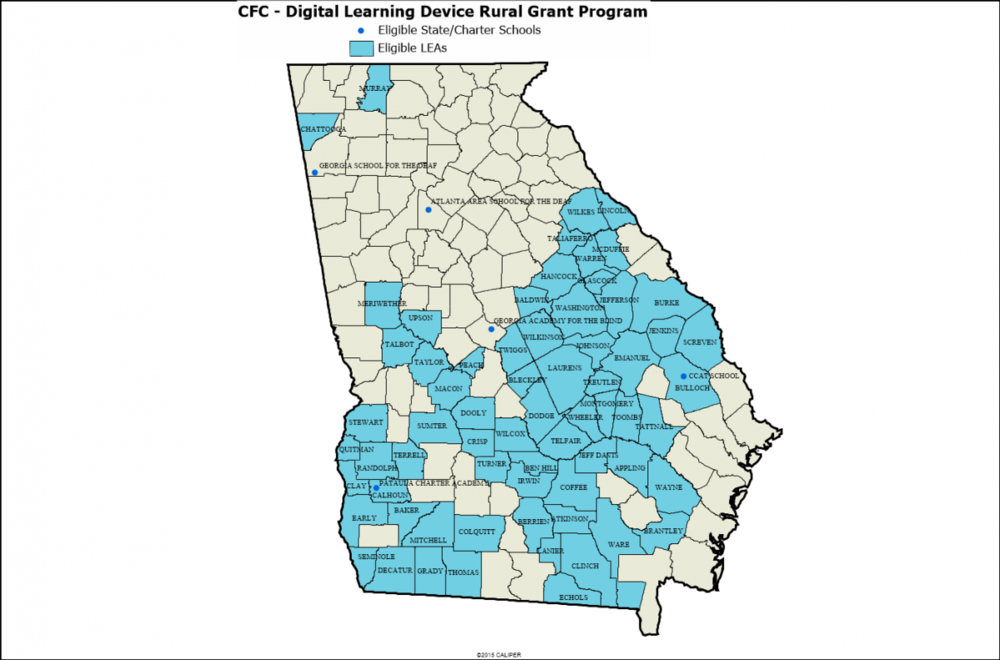
2016 CFC Program Information
Digital Learning Device Rural Grant Program
Overview
In the first three rounds of the Connections for Classrooms Grant Program, $77 million in grants have been awarded to 159 LEAs for district and school network upgrades. As a result, many schools now have or will soon have wireless internet access to their classrooms. However, many schools, particularly those in rural and high-need areas, lack resources to purchase sufficient devices to fully leverage the increased connectivity.
With this limitation in mind, GOSA announced a new round of competitive grant funding, the Digital Learning Device Rural Grant Program in July 2016. This round will enable rural, high-need districts that are poised to implement digital learning to purchase laptops, tablets, or other mobile devices used for instruction. Approximately $5 million in grants will be available in this round.
Due to limited funding, this round includes a competitive application submission and review process to determine awards. Strong applicants will clearly describe how this grant will enable them to change instruction to implement digital learning, specifically facilitating learning with technology that gives students some control over time, place, path, and/or pace. In addition, they will demonstrate their need for devices, outline their device selection/deployment/maintenance plans, and provide assurance of network preparedness to support devices.
Grant program information, including the Grant Application, Scoring Rubric, Grant Program Procedures Document, Applicant Eligibility, and FAQs are available in the table at the bottom of this page.
Grant Awards
On December 21, 2016, Governor Deal announced that 33 rural, high-need school districts will be awarded nearly $4 million from the Digital Learning Device Rural Grant Program. Click here for the award announcement and list of awardees.
Timeline
- July 21, 2016: Digital Learning Device Rural Grant Program application window opens
- September 7, 2016: 2:00-3:00 PM.
Webinar Presentation . Unfortunately, there were technical difficulties recording the webinar, so we do not have a recording. We have updated the FAQs, linked in the table below, with any questions that were answered in the presentation that were not already addressed in that document. If you have any remaining questions, please contact Steve Korwan at [email protected].
- November 1, 2016: The application window will close at 5:00 PM ET. Please note that the deadline has been extended by one week from October 25 to November 1 due to district recovery efforts for Hurricane Matthew. APPLICATIONS ARE NOW CLOSED.
- November-December, 2016: Applications will be scored by independent reviewers.
- December 2016: Award announcements will be made.
With approximately $4 million in remaining Connections for Classrooms grant funds through the OneGeorgia Authority, the Governor’s Office of Student Achievement (GOSA) has announced a new grant program focused on providing needed funds to rural Georgia districts that face significant challenges in having sufficient devices for students to authentically participate in digital learning.
Eligible Applicants
To accomplish this goal, GOSA narrowed the eligible local education authorities (LEAs) program to include only LEAs that meet both of the following criteria:
- High-Need: LEAs located in one of 71 Tier 1 counties using the Georgia Department of Community Affairs’ annual job tax credit tiers. These counties represent the counties with the highest unemployment rate, lowest per capita income, and highest percentage of residents whose incomes are below the poverty level in the state. In addition to being districts with high student need, the economic conditions make it less likely that these districts are able to bridge the device gap with BYOD policies and local purchases.
- Rural: LEAs serving less than 25 students per square mile. These LEAs must spend proportionally more funds per pupil since they serve a more dispersed population and do not have the economies of scale of larger districts. In addition, students are more likely to spend more time on buses and have more limited dual enrollment opportunities, making digital learning more important.
The three State Schools are also eligible. In addition, state charter schools that are located in a Tier 1 County and have an attendance zone in which all LEAs are eligible for the grant are also eligible. Using these criteria, the LEAs on the map below are eligible.

Eligible Funds
Each eligible LEA will be able to apply for up to $75 per student, as counted in the March 2016 FTE Count. These funds are not intended to purchase a $75 device per student. Rather, as a whole, the total eligible funding amount derived from the $75/student should be used for devices that will best serve the students. All devices must be compliant with Georgia Milestones minimum standards.
Grant Program Important Documents
|
Detailed information on the grant program application, scoring, administration, and reimbursement. The Appendix includes the rubric that will be used to score applications. Released July 21, 2016 |
|
|
This document walks applicants through the online application step by step and allows them to fill it out in a Word document before submitting it online. Released July 21, 2016 |
|
|
|
This spreadsheet should be filled out and attached to the online application to outline the projected total budget and number of devices in each school. Released July 21, 2016 |
|
The rubric that independent reviewers will use to score applications. Released July 21, 2016 |
|
|
Frequently asked questions and answers for the Digital Learning Device Rural Grant Program. Released July 21, 2016, Updated September 15, 2016 with answers to questions from the Grant Application Webinar. |
|
|
This document explains the criteria used to determine which LEAs would be eligible to apply for funding. Released July 21, 2016 |
|
|
This spreadsheet provides the maximum amount of funds for which an eligible LEA can apply (calculated as $75 per student in the March 2016 FTE count). Released July 21, 2016 |